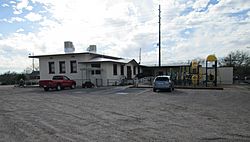Continental, Arizona facts for kids
Quick facts for kids
Continental, Arizona
|
|
|---|---|

The Continental Community Center in 2014.
|
|
| Country | United States |
| State | Arizona |
| County | Pima |
| Elevation | 2,864 ft (873 m) |
| Time zone | Mountain (MST) |
| Area code(s) | 520 |
| Post Office opened | May 26, 1917 |
| Post Office closed | February 28, 1929 |
Continental is a small community in Pima County, Arizona, United States. It's about 25 mi (40 km) south of Tucson. You'll find it close to the towns of Sahuarita and Green Valley. Continental used to be a big place for growing cotton. Today, it's mostly surrounded by huge pecan orchards. It's also very close to Madera Canyon. This area is famous for birdwatching and is a popular spot for visitors. It's nestled in the beautiful Santa Rita Mountains.
Contents
History of Continental
Continental was founded in 1916 during World War I. President Woodrow Wilson asked a company to grow a special plant. This plant was called guayule. Guayule produces latex, which can be used to make rubber. At the time, many Americans worried that Germany might stop rubber imports.
Early Days and Rubber Farming
In 1916, the Intercontinental Rubber Company started the Continental Farm. It was located south of Sahuarita, near the Santa Cruz River. A small town quickly grew around the farm. This town was built for the workers. Around 1918, large adobe homes were built for the farmers. The town also had fields and a factory for processing guayule.
Continental soon had its own post office, which opened in 1917. A schoolhouse was built in 1918. There was also a church and a general store. The town even had its own cemetery. However, the guayule project ended after World War I. In 1922, Queen Wilhelmina of the Netherlands bought the farm. She rented the fields to farmers who grew cotton until 1949.
The Bull Farm and a Movie Set
In 1926, a farmer named James B. Bull bought land nearby. He called it the Bull Farm. James grew alfalfa, vegetables, and grains there. The Bull Farm grew to be one of the largest in the area. It covered 6,150 acres.
In 1939, the Bull Farm was used for filming a movie. The movie was called The Westerner. It starred the famous actor Gary Cooper.
World War II Camp
During World War II, in late 1944, the United States Army built a camp. This camp was for German POWs. It was called Camp Continental. The camp was designed to hold 250 prisoners and forty guards. Because there weren't enough workers during the war, the prisoners helped work in the nearby fields. There were some challenges at the camp, but not much is known about them. Today, nothing remains of the camp. In 1989, the area where the Bull Farm was became a retirement community called Quail Creek.
Pecans and Modern Continental
In 1948, R. Keith Walden moved his company, Farmers Investment Company (FICO), to Arizona. He bought the Continental Farm to use as his main office. In the 1950s, Keith worried about the future of cotton. So, in 1965, he decided to grow pecans instead. He chose pecans because they grow well in the Sonoran Desert climate.
FICO is still owned by the Walden family today. Their pecan orchards are now the largest pecan grove in the world.
Today, some of the old adobe homes in Continental are still used. The old Continental School was replaced in the 1990s. A new school was built about a mile to the east. The old school building was fixed up and is now the Continental Community Center. The Continental Cemetery is located northeast of the old school. It is now surrounded by the Madera Reserve neighborhood. Local Native Americans consider the cemetery a holy place. It has been used since 1903. The oldest marked grave there is from 1918.
Gallery
-
Graves at the Continental Cemetery with the Santa Rita Mountains in the background







